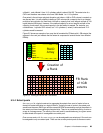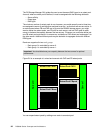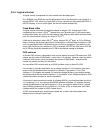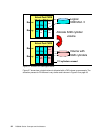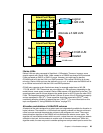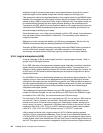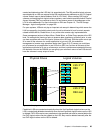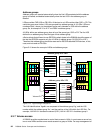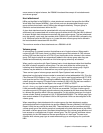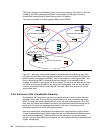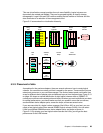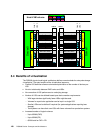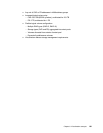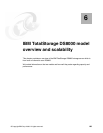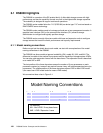Chapter 5. Virtualization concepts 97
server access to logical volumes, the DS8000 introduced the concept of host attachments
and volume groups.
Host attachment
HBAs are identified to the DS8000 in a host attachment construct that specifies the HBAs’
World Wide Port Names (WWPNs). A set of host ports can be associated through a port
group attribute that allows a set of HBAs to be managed collectively. This port group is
referred to as host attachment within the GUI.
A given host attachment can be associated with only one volume group. Each host
attachment can be associated with a volume group to define which LUNs that HBA is allowed
to access. Multiple host attachments can share the same volume group. The host attachment
may also specify a port mask that controls which DS8000 I/O ports the HBA is allowed to log
in to. Whichever ports the HBA logs in on, it sees the same volume group that is defined in
the host attachment associated with this HBA.
The maximum number of host attachments on a DS8000 is 8192.
Volume group
A volume group is a named construct that defines a set of logical volumes. When used in
conjunction with CKD hosts, there is a default volume group that contains all CKD volumes
and any CKD host that logs into a FICON I/O port has access to the volumes in this volume
group. CKD logical volumes are automatically added to this volume group when they are
created and automatically removed from this volume group when they are deleted.
When used in conjunction with Open Systems hosts, a host attachment object that identifies
the HBA is linked to a specific volume group. The user must define the volume group by
indicating which fixed block logical volumes are to be placed in the volume group. Logical
volumes may be added to or removed from any volume group dynamically.
There are two types of volume groups used with Open Systems hosts and the type
determines how the logical volume number is converted to a host addressable LUN_ID on the
Fibre Channel SCSI interface. A
map volume group type is used in conjunction with FC SCSI
host types that poll for LUNs by walking the address range on the SCSI interface. This type of
volume group can map any FB logical volume numbers to 256 LUN_IDs that have zeroes in
the last six bytes and the first two bytes in the range of X'0000' to X'00FF'.
A
mask volume group type is used in conjunction with FC SCSI host types that use the Report
LUNs command to determine the LUN_IDs that are accessible. This type of volume group
can allow any and all FB logical volume numbers to be accessed by the host where the mask
is a bitmap that specifies which LUNs are accessible. For this volume group type, the logical
volume number X'abcd' is mapped to LUN_ID X'40ab40cd00000000'. The volume group type
also controls whether 512 byte block LUNs or 520 byte block LUNs can be configured in the
volume group.
When associating a host attachment with a volume group, the host attachment contains
attributes that define the logical block size and the Address Discovery Method (LUN Polling or
Report LUNs) that are used by the host HBA. These attributes must be consistent with the
volume group type of the volume group that is assigned to the host attachment so that HBAs
that share a volume group have a consistent interpretation of the volume group definition and
have access to a consistent set of logical volume types. The GUI typically sets these values
appropriately for the HBA based on the user specification of a host type. The user must
consider what volume group type to create when setting up a volume group for a particular
HBA.



